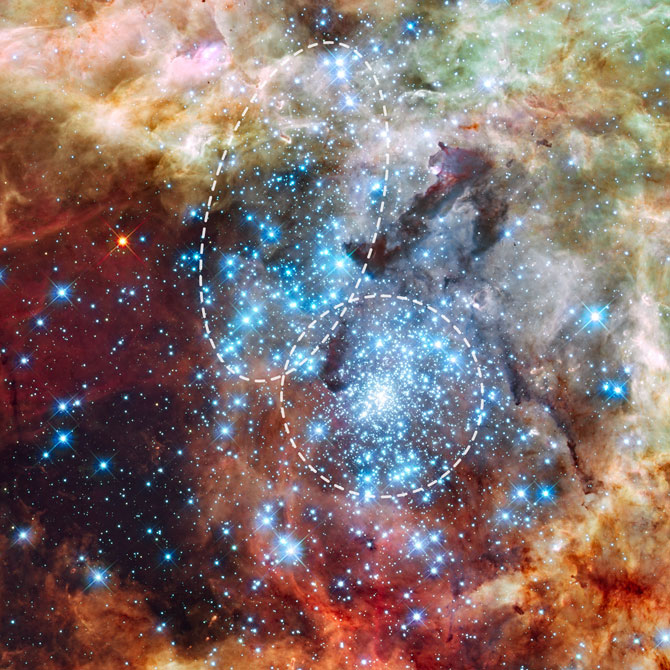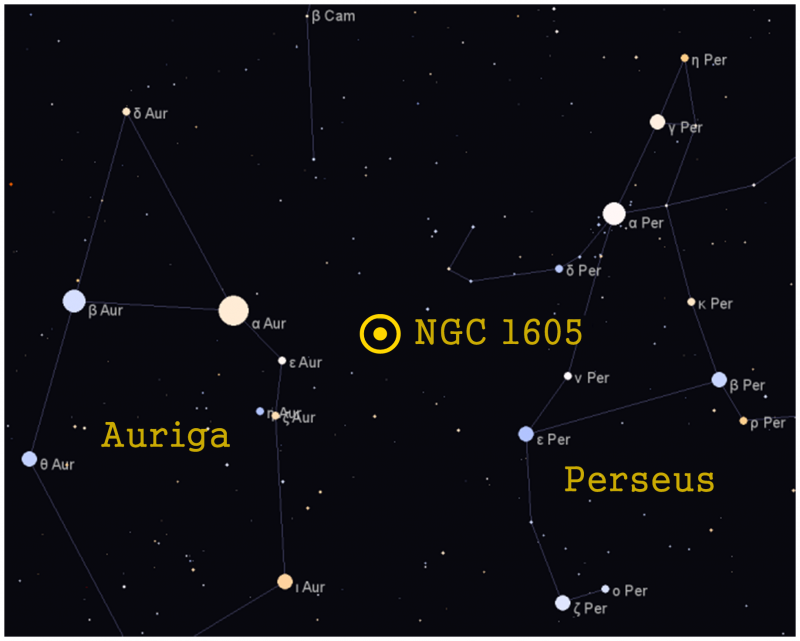
Old open star clusters merging
Open star clusters tend to be young collections of sibling stars, born together from a cosmic cloud or nebula in space. Open clusters are like families of stars. They’re still loosely bound by gravity and still moving together through space. We know thousands of them in our Milky Way galaxy, and amateur astronomers love to gaze at them through small telescopes and binoculars, under dark skies. Most open star clusters don’t survive more than several orbits around our galaxy’s center before being disrupted and dispersed. But astronomer Denilso Camargo in Brazil reached out this week (early October 2021) about a new discovery of what he called:
… the first old binary star cluster within our Milky Way galaxy.
Close encounters between open star clusters are rare, he said. Obviously, the subsequent formation of binary clusters is even rarer. And the evolution to a merger event is extremely unlikely. Yet there it is. And that’s not all. Camargo said this system appears to be undergoing a merger during a close encounter. As the two star clusters merge, Camargo said, they’re leaving in their wake:
… streams populated by bound substructures.
That’s the kind of news you’d expect to hear from ESA’s Gaia space observatory. And indeed Camargo used Gaia data, along with images from NASA’s WISE infrared space telescope. The study is accepted for publication in the peer-reviewed Astrophysical Journal (preprint here).

One cluster becomes 2
Camargo is at the Federal University of Rio Grande do Sul in Porto Alegre, Brazil. Via data from the two space observatories, he closely examined a single known open cluster called NGC 1605 and found it was really two clusters. NGC 1605 one of the open star clusters amateur astronomers like to see. As deep-sky objects go, it’s relatively bright (about 11th magnitude) and can be seen with a 6-inch or larger telescope (in a dark sky). One known cluster has become two, so, Camargo said:
I called the two clusters as NGC 1605a and NGC 1605b.
Camargo said his study reveals one cluster is 2 billion years old, and the other only 600 million years old. And those ages give a clue to the clusters’ histories. Writing for IFLScience on October 4, 2021, Stephen Luntz explained:
It’s clear NGC 1605a and b are unlike anything else we have seen. Most binary clusters are young, which probably indicates they formed together from a single cloud that broke apart. That can’t be the case for a pair of such different ages.
Instead, these two must have been drifting past each other, and come close enough their gravitational fields caused them to interact. The two have now come so close their star populations overlap.
Streams of bound systems
And – because of subtle effects of gravity – the clusters overlap in a way that might not have occurred to us. That is, Camargo’s study describes stellar groups pulled out from NGC 1605a and NGC 1605b by tidal effects. He spoke of:
… tidal debris distributed along tidal streams.
And, he said, surprisingly:
… some of them may survive as bound stellar systems.
So this study presents a new image to contemplate. It suggests two old open clusters in the Milky Way, born in two separate “families,” sweeping close to one another and beginning to merge. And in the process, the clusters’ stars are being drawn by gravity into long streams (populated by smaller clusters, perhaps even mutiple star systems), which move in the clusters’ wake through the Milky Way. Imagine standing on a planet in one of those systems! Camargo explained it this way:
I suggest that during the close encounter, stellar groups are been pulled out of the merging clusters by tidal interactions and these substructures are forming new star clusters distributed along tidal streams that trace the two clusters path.
And it’s why he called this study:
… a paradigm shift.
It is quite marvelous to think about!

Bottom line: Astronomer Denilso Camargo in Brazil has looked toward a known open star cluster and found two old open star clusters, merging in our Milky Way galaxy.
Source: NGC1605a and b: an old binary open cluster in the Galaxy
The post 2 old open star clusters merging in the Milky Way first appeared on EarthSky.
from EarthSky https://ift.tt/3iB5u3t

Old open star clusters merging
Open star clusters tend to be young collections of sibling stars, born together from a cosmic cloud or nebula in space. Open clusters are like families of stars. They’re still loosely bound by gravity and still moving together through space. We know thousands of them in our Milky Way galaxy, and amateur astronomers love to gaze at them through small telescopes and binoculars, under dark skies. Most open star clusters don’t survive more than several orbits around our galaxy’s center before being disrupted and dispersed. But astronomer Denilso Camargo in Brazil reached out this week (early October 2021) about a new discovery of what he called:
… the first old binary star cluster within our Milky Way galaxy.
Close encounters between open star clusters are rare, he said. Obviously, the subsequent formation of binary clusters is even rarer. And the evolution to a merger event is extremely unlikely. Yet there it is. And that’s not all. Camargo said this system appears to be undergoing a merger during a close encounter. As the two star clusters merge, Camargo said, they’re leaving in their wake:
… streams populated by bound substructures.
That’s the kind of news you’d expect to hear from ESA’s Gaia space observatory. And indeed Camargo used Gaia data, along with images from NASA’s WISE infrared space telescope. The study is accepted for publication in the peer-reviewed Astrophysical Journal (preprint here).

One cluster becomes 2
Camargo is at the Federal University of Rio Grande do Sul in Porto Alegre, Brazil. Via data from the two space observatories, he closely examined a single known open cluster called NGC 1605 and found it was really two clusters. NGC 1605 one of the open star clusters amateur astronomers like to see. As deep-sky objects go, it’s relatively bright (about 11th magnitude) and can be seen with a 6-inch or larger telescope (in a dark sky). One known cluster has become two, so, Camargo said:
I called the two clusters as NGC 1605a and NGC 1605b.
Camargo said his study reveals one cluster is 2 billion years old, and the other only 600 million years old. And those ages give a clue to the clusters’ histories. Writing for IFLScience on October 4, 2021, Stephen Luntz explained:
It’s clear NGC 1605a and b are unlike anything else we have seen. Most binary clusters are young, which probably indicates they formed together from a single cloud that broke apart. That can’t be the case for a pair of such different ages.
Instead, these two must have been drifting past each other, and come close enough their gravitational fields caused them to interact. The two have now come so close their star populations overlap.
Streams of bound systems
And – because of subtle effects of gravity – the clusters overlap in a way that might not have occurred to us. That is, Camargo’s study describes stellar groups pulled out from NGC 1605a and NGC 1605b by tidal effects. He spoke of:
… tidal debris distributed along tidal streams.
And, he said, surprisingly:
… some of them may survive as bound stellar systems.
So this study presents a new image to contemplate. It suggests two old open clusters in the Milky Way, born in two separate “families,” sweeping close to one another and beginning to merge. And in the process, the clusters’ stars are being drawn by gravity into long streams (populated by smaller clusters, perhaps even mutiple star systems), which move in the clusters’ wake through the Milky Way. Imagine standing on a planet in one of those systems! Camargo explained it this way:
I suggest that during the close encounter, stellar groups are been pulled out of the merging clusters by tidal interactions and these substructures are forming new star clusters distributed along tidal streams that trace the two clusters path.
And it’s why he called this study:
… a paradigm shift.
It is quite marvelous to think about!

Bottom line: Astronomer Denilso Camargo in Brazil has looked toward a known open star cluster and found two old open star clusters, merging in our Milky Way galaxy.
Source: NGC1605a and b: an old binary open cluster in the Galaxy
The post 2 old open star clusters merging in the Milky Way first appeared on EarthSky.
from EarthSky https://ift.tt/3iB5u3t

Aucun commentaire:
Enregistrer un commentaire